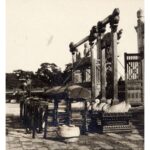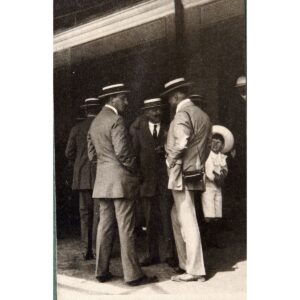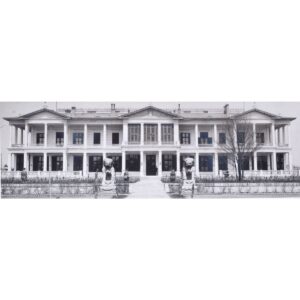Photography Music Instruments in Front of the Yuanqiu Altar
A black-and-white photograph showing musical instruments at the foot of the Yuanqiu Altar (Yuanqiutan 圜丘壇), which literally means “Circular Hill Temple”. The altar stands on a fenced area of several hectares in the southern part of the Temple of Heaven complex (Tiantan 天壇). It was built in 1420 by the Yongle Emperor (reigned 1402–1424). Here the emperors of the Ming and Qing dynasties performed the rites of heaven worship twice a year. At the site of the Yuanqiu Altar, on the day of the winter solstice, the emperor performed rituals of thanking heaven for its favours in the past year.
Dance and musical elements played an important role in the rituals of the worship of heaven. Rehearsals took place throughout the year. They were supervised by the Shenleshu 神樂署 Bureau of Sacred Music, which had its own premises in the northwestern part of the complex. The winter solstice ritual began with dance and ritual music zhonghe shaoyue 中和韶樂, ... more
A black-and-white photograph showing musical instruments at the foot of the Yuanqiu Altar (Yuanqiutan 圜丘壇), which literally means “Circular Hill Temple”. The altar stands on a fenced area of several hectares in the southern part of the Temple of Heaven complex (Tiantan 天壇). It was built in 1420 by the Yongle Emperor (reigned 1402–1424). Here the emperors of the Ming and Qing dynasties performed the rites of heaven worship twice a year. At the site of the Yuanqiu Altar, on the day of the winter solstice, the emperor performed rituals of thanking heaven for its favours in the past year.
Dance and musical elements played an important role in the rituals of the worship of heaven. Rehearsals took place throughout the year. They were supervised by the Shenleshu 神樂署 Bureau of Sacred Music, which had its own premises in the northwestern part of the complex. The winter solstice ritual began with dance and ritual music zhonghe shaoyue 中和韶樂, which was intended to invoke all the gods and powers. This has its roots in the ancient rituals of the worship of the sky. The stylised exchange of the various musical instruments symbolises the dialogue between man and earth. The Office of Sacred Music otherwise took care of the archiving and performance of all ritual music in the empire, administered musical instruments, and trained musicians and dancers. In different historical periods, between 300 and 2,200 people worked in this office at once.
The entire area around the Yuanqiu Altar is only a few hectares in size and is part of the 273-hectare Temple of Heaven complex, now located in southeastern Beijing. The winter ritual for worshipping heaven was different from the summer ritual. The end of the period of abstinence in the Hall of Fasting (Zhaigong 齋宮) and the beginning of the sacrificial ceremony at the Yuanqiu altar was heralded by the ringing of the Gulou Bell Tower 鼓樓 at this site. The nine-part ritual included the rites of reporting and bowing to heaven, libation, sacrifice, and ritual music of zhonghe shaoyue 中和韶樂 with dance. The last emperor to bow to heaven in the Temple of Heaven was Yuan Shikai 袁世凱 (reigned 1915–1916), who for several months tried in vain to revive the monarchy. This marked the end of a centuries-old tradition. Today, the Temple of Heaven is on the UNESCO World Heritage List, as it is the largest religious complex in the world.
The photograph is the 183rd of 449 photographs of Beijing and its surroundings in the album of Ivan Skušek Jr., purchased during his stay in Beijing (1914–1920). In the handwritten inventory of the album, the photograph is referred to as Himmels-Tempel: Musik-Instrumente (nur an Opfertagen). (DZ, MV)



































Do you have a comment or additional information about the subject?